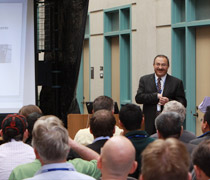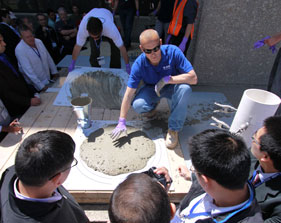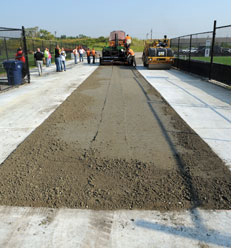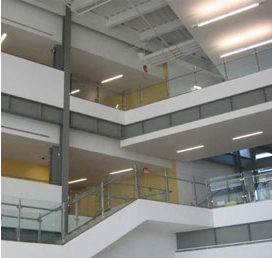It’s fast. It flows. It’s smooth in the finish and strong for the long haul.
And now, fresh innovations will make self-consolidating concrete even more popular with architects, engineers and builders around the world, say experts who gathered in Chicago earlier this month at the 5th North American Conference on Self-Consolidating Concrete.

More than 200 materials scientists from 35 countries attended the event, including 5 technical and quality control experts from Prairie Material. Sessions throughout the 3-day conference showcased new research findings in materials, mix design, production and performance, leading up to a live demo and workshop hosted by Dr. Mohsen A. Issa of the Department of Civil and Materials Engineering at the University of Illinois Chicago.
Observers at the demo watched as SCC provided by Prairie’s Yard 33 flowed into a 6-foot-high, U-shaped form built by Dr. Issa’s graduate students. The form’s Plexiglas surfaces revealed the mix’s stability as it flowed down one narrow channel, across the form’s bottom and up the other vertical leg with no segregation.
New tools, methods for field testing

The demo continued as smaller batches were loaded into wheelbarrows, and Joe Daczko of BASF and Ara Jeknavorian of W.R. Grace demonstrated hands-on testing of slump flow, passability and visual stability index (VSI). Using a field rheometer, Jeknavorian showed observers how to test for shear rate, viscosity and yield stress rate.
On-site tests of this kind support lab findings, ultimately making it possible to produce better SCC in the field, Daczko pointed out. “You can’t do every lab test in the field, but every field test should also be done in the lab,” he explained. “That’s how we know what the values tell us and what adjustments to make for better performance.”
Unique mixes for sustainable building
“We’re amazed by the research presented here this week and we’re seeing some advances we can put to work almost right away,” said Steve Fleming, Prairie’s technical services director.
Fleming named better field testing methods, lightweight SCC, new mixes that incorporate nanomaterials and fiber-reinforced SCC among the near-term trends to watch.
In the years ahead, builders will also benefit from advances that will make SCC a favored material for sustainable construction, he noted.
“The goal is to reduce the carbon footprint and make SCC more eco-friendly, with greater proportions of supplementary cementitious materials and recycled aggregates,” said Dr. Kejin Wang of Iowa State University, chair of the conference. Researchers shared findings on innovative mixes that incorporate recycled concrete, byproduct sand, waste tire rubber aggregate and even the residue from palm oil manufacturing.
Worldwide look at successful projects
Case studies presented at the conference revealed SCC’s potential in a growing variety of projects and settings:
- Bridge structures from Arkansas to Australia to Saudi Arabia showed SCC’s strength and versatility, including one from Northern Ireland featuring an SCC bridge deck.
- High-speed rail lines in China used SCC as a super-tough base layer, and rock-filled concrete dams throughout the country took full advantage of SCC’s flowability and finished strength.
- The underwater intake tunnel placed 2 miles offshore and 750 feet below the surface of Nevada’s Lake Mead utilized a unique SCC tremie mix.
Watch: Steve Fleming live at the 2013 SCC conference demo.
Innovation to help you lead
Many of the cutting-edge concepts shared at the conference are still a few years away from implementation but, as Steve Fleming puts it, “It’s our job to know what’s next. Mixes and techniques that solve common problems today were new a decade ago. We aim to stay ahead of the curve so Prairie customers benefit sooner from every advance.”





 United Materials
United Materials Superior Materials
Superior Materials Prairie Materials
Prairie Materials Canada Building Materials
Canada Building Materials VC Global
VC Global